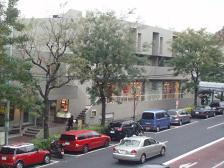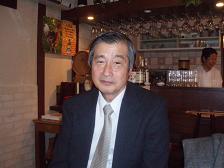インタビュー(8)元倉眞琴さん: Interview with Mr. Motokura [インタビュー]
インタビュー:元倉眞琴さん(スタジオ建設計画代表取締役、東北芸術工科大学教授)
Interviewee: Mr. Makoto Motokura (President, Studio Kensetsu Keikaku, and Professor, Tohoku University of Art & Design)


元倉眞琴さん ヒルサイドテラスB棟2階のオフィス前で
Mr. Motokura in Front of His Office at Hillside Terrace B (2nd floor)
12月8日(金)午後2:00にヒルサイドテラスB棟にある元倉さんのオフィスに伺い、代官山に関連する幅広い活動についてゆっくりお話しをお聞きしました。
元倉さんは、代表的な著作のタイトル「集まって住む」ことをライフワークとして追及している建築家といえます。この「集まって住む」という発想は、元倉さんが育った東京台東区の「下町」で見られるような色々な人が集まり助け合って生活している町のあり方から自然に出てきたもので、それを建築という専門分野の視点から実現しようと努力されてきました。
元倉さんが代官山を最初に訪問したのは1960年代末のまだ学生の頃で、完成したばかりのヒルサイドテラスA・B棟の白い建物がまだ牧歌的な周辺をバックに際立っていたことが今でも印象に強く残っているとのことです。大学卒業後、縁があって槙文彦設計事務所に入り、ヒルサイドテラスのその後の設計(特にD・E棟およびAnnex)などに携ることになりましたが、その際に槙氏の「まち」の視点から建築を考える姿勢が自分の信条に合うことで意を強くし、それが独立して設計事務所を構えられた後も大きなバックボーンになっています。
『集まって住む』:http://www.bk1.co.jp/product/2544549
元倉さんはこのような視点から、最近の代官山の動向に対して大きな危機感を持っています。2000年のアドレス完成前後から、それまでのゆっくりとしたヒューマンスケールの望ましい町が、再開発による商業化・高層化の波に飲み込まれ消費され尽くして、後には何も残らなくなるのではないか。特に問題なのは、人がマンションなどの建物の中にこもって町や通りに出てこなくなることで、そのために望ましいコミュニティが崩壊していくことを心配しています。
そのような動向をどうしたら逆転できるかが大きな課題で、そのヒントは元倉さんの原点である下町の長屋や町屋にあるといえます。そのような昔の暮らし方から学んで、いかに代官山の「まち」における人々の生活と交流のコミュニティを再生させるかを建物家として探求しているとのことです。
その点で、同じ「コミュニティの崩壊と再生」というテーマで元倉さんがかかわっているのが、東北芸術工科大学が支援しているプロジェクト「あたらしいがっこう」です。これは東北のある集落のコミュニティが少子化による廃校によって崩壊した状況を何とか救うために、閉鎖された校舎を「だれでも教えてだれでも学べる学校」というコンセプトで、集落の住民全員がかかわれるような場にすることによりコミュニティを再生させようという試みです。色々なイベントを行なったり、ギャラリーとして利用するなどの工夫をして住民に認知されてきているとのことです。ある意味では、これは代官山におけるヒルサイドテラスのコミュニティ活動と通じるものがあるようです。
コラム「あたらしいがっこう」:
http://www.tuad.ac.jp/community/backnumberfiles/05-01/column/column.html
元倉さんが見るところ代官山の今後の課題は、まちづくりをリードする人たちのつながりをどのように維持・拡大していくかで、これまでは同じ大学出身の仲間意識が潤滑油としてうまく機能してきたが、今後ともそれが続くかどうかという疑問を呈しています。これからはオープンな代官山コミュニティに参加してくる人たちと意見交換して優れた考え方を育て、代官山からさらなる知的な発信をするような場、つまり「あたらしいがっこう」をどうしたら作ることができるかが問題です。
その点で、元倉さんが中心となって運動した結果、重要文化財として保存することが決まった「旧朝倉邸」の将来の利用に関する一つの可能性として、そのような知的な活動の拠点とすることがあるかもしれないと、元倉さんは希望を述べられていました。
代スキ会「旧朝倉邸と庭園の将来を考える会」:
http://www.daikanyama.ne.jp/activities/asakura2/index.html
インタビューを終えた帰り道に、「いろいろとゆっくりお話しできてよかったです」という別れ際の元倉さんの暖かい言葉がいつまでも耳に残るとても心地よい代官山の午後の時間でした。
元倉さんのホームページ:
http://www.jcarb.com/KenchikukaShousai_9501630.html
スタジオ建築計画のウェブサイト:
http://www.kenchiku-keikaku.com/
I visited Mr. Motokura’s office at Hillside Terrance B around 2pm on December 8, and interviewed him on his wide-ranging activities about Daikanyama.
Mr. Motokura is an architect who is searching for what the title of his representative book, “Living Together,” means as his lifework. This concept, “Living Together,” naturally grew out of his childhood experience of living collectively with various kinds of people who were supporting each other as neighbors in the “shitamachi” area of Taito-ku, Tokyo, and as an architect, he has since been trying to realize this concept from the architectural standpoint.
Mr. Motokura visited Daikanyama for the first time in the late 1960s, when he was a college student, and still vividly remembers the white structure of the newly built Hillside Terrace A & B against an old residential background. After graduation, he joined Maki Architecture/Design Office and worked on the design for Hillside Terrace D & E as well as Annex, where he could confirm his belief by learning Mr. Maki’s stance that architecture should be approached from the viewpoint of community development. This belief has become a strong backbone for Mr. Motokura’s work since he opened his own office.
Makoto Motokura, “Living Together”:
http://www.bk1.co.jp/product/2544549
From this viewpoint, Mr. Motokura has a sense of crisis about recent developments in Daikanyama. His concern is that this city might be overwhelmed by the tide of highrise commercial development, destroying the community of the human scale, which had been fostered gradually until the construction of Daikanyama Address in 2000. Especially problematic is the fact that the desirable community is disintegrating because residents lock up themselves inside condominiums/apartments and do not go out to see each other on the streets in their community.
How to reverse this trend is a big challenge for everyone and, according to Mr. Motokura, some hints might be obtained from his original experience of collective living in “nagaya” or “machiya.” By learning from such traditional living style, he is trying to revive the community of human life in Daikanyama as an architect.
With regard to the theme “disintegration and revival of a community,” Mr. Motokura also is being involved in a project, “New Schooling,” supported by Tohoku University of Art and Design. This is an experimental project to revitalize a rural community by utilizing a closed school building for all community members to be involved in teaching/learning activities regarding community matters, where Mr. Motokura has helped them organize various events and open a gallery. This seems somewhat like community activities often held at Hillside Terrace.
Makoto Motokura, “New Schooling”
(TUAD On-Line Community Magazine):
http://www.tuad.ac.jp/community/backnumberfiles/05-01/column/column.html
As Mr. Motokura sees it, a challenge for Daikanyama is to keep and expand the network of community leaders in the future. For this purpose, Daikanyama may need its own “New Schooling,” where community leaders can interact with newcomers for mutual learning to nurture creative ideas.
In this connection, Mr. Motokura has been quite active in the movement to save and maintain the old Asakura residence, which was recently designated as an important cultural asset by the government, and intends to propose its possible use as a center for teaching and learning, that is “New Schooling,” for the Daikanyama community.
Daisuki-Kai “Movement for the Future of the Old Asakura Residence and Garden”
http://www.daikanyama.ne.jp/activities/asakura2/index.html
Mr. Motokura’s Homepage:
http://www.jcarb.com/KenchikukaShousai_9501630.html
Website for Studio Kenchiku Keikaku:
http://www.kenchiku-keikaku.com/
インタビュー(7)鈴木さん・岩橋さん:Interview with Mr. Suzuki/Mr. Iwahashi [インタビュー]
インタビュー:鈴木正慶さん(中部大学教授)・岩橋謹次さん(アスピ代表)
Prof. Masayoshi Suzuki (Chubu Univ) & Mr. Kinji Iwahashi (ASPI)


@ル・ビストロ・パッション:http://www.pachon.co.jp/jpn/bistro_broche/
12月8日(金)に、たまたま1週間前の「挑戦者たちの忘年会」(本ブログ12月1日の写真参照)の立役者である鈴木さんと岩橋さんが会ってランチを共にされる場に参加する機会があったので、その際の会話を以下インタビュー要旨という形でまとめてみました。
お二人の関係はそもそも大学時代にまでさかのぼるそうで、岩橋さんは「特に代官山に来て以来、鈴木さんにはいつも背中を押されて仕事をしてきた」といわれています。特に岩橋さんのコンサルタントとしての仕事の看板になっている「チェンジ・エージェント」(Change Agent)という言葉は鈴木さんからいただいたとのことです。
「アスピはチェンジ・エージェント」:http://www.aspi.co.jp/page2-1.htm
他方、鈴木さんは、岩橋さんの代官山に対するスタンスやポリシーが最初から今日にいたるまで一貫しており、まったくぶれないことを高く評価しています。鈴木さん自身は、日本経済の将来を背負って立つ独創的な起業家を育てる仕事を長年続けており、それも「ものづくり」の伝統がある中部地方を拠点として、地に足の着いた新規ビジネスを立ち上げる若者を支援することを続けてきたそうです。その結果、先日の忘年会の参加者のように、新しいビジネスで頭角をあらわす次世代の起業家が出てきたことは嬉しいかぎりです。
ただし鈴木さんによれば、日本の問題点は個々人が能力的に優秀でも、世界の舞台でグローバルなルール作りに参加できる人材が少ないことで、これはビジネスの世界でも、鈴木さんが学生時代から続けている柔道などのスポーツの世界でもいえるとのことです。
(鈴木さんの社会活動:各種ベンチャー企業顧問・社外取締役、財団法人全日本柔道連盟委員)
http://www.chubu.ac.jp/about/faculty/profile/e61369f0f7753994661780584e71a6d7f36e2685.html
今後の代官山の課題としては、この街を真の意味で「エクセレントなセンター」(COE)、つまり創造的なクラスターにするために次世代のリーダーを育てることで、そのために先日の忘年会のように異なる世代や異なる分野のメンバーが自由に交流する場を代官山に作ることであるという点で、鈴木さんも岩崎さんも意見が一致。実際に、それぞれの分野で確立した先輩方のほんの一言が、次の世代の若者にとっては大きなヒントや励みになるものです。ある意味で、鈴木さんと岩橋さんの関係もそれに似たものがあったのかもしれません。
以上、ほんの1時間ほどでしたが、代官山でなければ得られない美味しい食事と和やかな雰囲気と生産的な会話を心行くまで堪能したランチタイムでした。
On December 8, I happened to join Mr. Masayoshi Suzuki and Mr. Kinji Iwahashi, who both were main host figures for last week's "year-end party" (see this blog for Dec. 1), and had lunch together in Daikanyama.
Their close relationship dates back to their college days, and Mr. Iwahashi says "I have been pushed forward by Mr. Suzuki since I started working in Daikanyama." For example, Mr. Iwahashi has adopted as the key word for his consulting business, "Change Agent," which was originally given to him by Mr. Suzuki.
"ASPI is Change Agent":http://www.aspi.co.jp/page2-1.htm
On the other hand, Mr. Suzuki highly appreciates Mr. Iwahashi's consistent stance and policy toward the Daikanyama community. Mr. Suzuki himself, based in the Chubu region, has long been supporting young entrepreneurs with original ideas, while emphasizing non-nonsense approaches in the tradition of creative manufacturing in the region. He is glad to see an increasing number of next-generation entrepreneurs appearing on the business scene, as we met at last week's year-end party.
His concern, however, is the fact that there are very few Japanese who can participate in rule-making activities in the international community, whether it is business or sports like Judo, which Mr. Suzuki has been practicing since his student days.
(Mr. Suzuki's volunteer activities: consulting/outside directors for venture business, and committee member, All Japan Judo Federation)
http://www.chubu.ac.jp/about/faculty/profile/e61369f0f7753994661780584e71a6d7f36e2685.html
In conclusion, Mr. Suzuki and Mr. Iwahashi agreed that a challenge for Daikanyama would be to foster and train next-generation leaders for this community to be a "Center of Excellence" (COE), or a creative cluster, and to provide a place in Daikanyama for free networking meetings of various members with different backgrounds in different generations, as seen at last week's year-end party. In fact, just a few words by well-established senior people could mean a lot to young junior members in their respective fields. In a sense, that might be the essence of the relationship between Mr. Suzuki and Mr. Iwahashi themselves.
Although it was just a matter of an hour or so for lunch, I fully enjoyed the good food, nice atmosphere, and productive conversation, that would be only possible in Daikanyama.
老若男女・挑戦者の忘年会:Year-end Party for Young/Old Challengers
代官山ステキ総合研究所のメンバーと鈴木正慶氏の起業家仲間の合同忘年会
Joint Party for Suteki Members & Mr. Suzuki's Friends/Entrepreneurs


乾杯の音頭をとる岩橋氏とお仲間に囲まれてご機嫌の鈴木氏(後方左より2人目)
Mr. Iwahashi Proposing a Toast & Mr. Suzuki with His Good Friends
参考:References
代官山ステキ研究所:http://www.daikanyama.ne.jp/dsi/index.php
鈴木正慶研究室:http://www.chubu.ac.jp/about/faculty/profile/e61369f0f7753994661780584e71a6d7f36e2685.html



